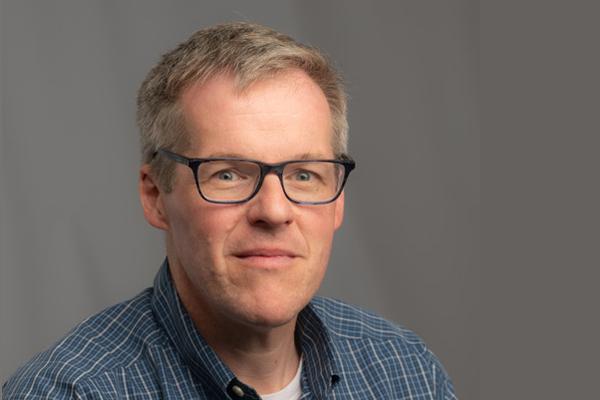

Two Ohio University physicists are advancing the frontiers of sub-atomic research—from the way nuclei are put together to the life cycle of stars—by developing artificial intelligence (AI) and computational tools to accelerate both theoretical and experimental research.
Christian Drischler and Daniel Phillips are playing a key role in a worldwide push to use new tools in the search for answers to some of physics’ biggest questions.
One project is taking on machine learning and AI, and the other has already released two versions of software to conduct Bayesian analysis of nuclear dynamics.
STREAMLINE
OHIO is one of six universities joining with three national laboratories on a new collaboration called STREAMLINE (SmarT Reduction and Emulation Applying Machine Learning in Nuclear Environments), recently announced as part of the Department of Energy’s $16 million initiative to develop machine learning and AI methods to accelerate scientific discovery in nuclear physics research.
The STREAMLINE collaboration brings together a team of leading researchers in applying artificial intelligence and machine learning to theoretical nuclear physics. Their work begins where nuclear theory and super-computing intersect—large-scale computations that can dramatically increase scientists' power to understand nuclear structure and predict dynamic phenomena.
"We're going to be looking at ways to solve some of the most challenging problems in computational nuclear many-body theory," said Drischler, assistant professor of physics and astronomy in the College of Arts and Science at Ohio University and a Bridge Faculty member of the Facility for Rare Isotope Beams (FRIB) Theory Alliance .
The "many-body problem" is central to the theory of quantum mechanics. The bodies are tiny particles, and the problem is that while the laws of physics effectively proscribe the properties of individual particles in the nucleus, the quantum system gets exponentially more complex as a collection of particles interact or "entangle."
In addition to OHIO, faculty in the project hail from Michigan State University, Florida State University, North Carolina State University, Ohio State University, and the University of Tennessee. The national labs involved include Argonne National Laboratory, Fermilab, and Oak Ridge National Laboratory.
The STREAMLINE team members are working to develop fast and accurate emulators, smart model extrapolation, and predictive models for nuclear dynamics, including nuclear fission and heavy-ion fusion. The group also plans an extensive program to educate the next generation of nuclear theorists.
"Our machine learning studies of correlated nuclear matter will impact experimental programs across the U.S." Drischler noted. Among the beneficiaries will be the Association for Research at University Nuclear Accelerator facilities (ARUNA), which includes the Edwards Accelerator Laboratory and the Institute for Nuclear and Particle Physics at Ohio University, and the new Facility for Rare Isotope Beams (FRIB) at Michigan State University.
BAND
The STREAMLINE collaboration also will be looking for synergies and overlap with several other projects underway, including the Bayesian Analysis of Nuclear Dynamics (BAND) , led by Ohio University Professor Phillips, an internationally known nuclear theorist.
Phillips is leading a $3.7 million, multi-institution effort to develop software that can create more accurate models of scientific phenomena — such as what happened in the microseconds after the Big Bang or how long a radioactive nucleus will live before it decays. This National Science Foundation-funded project involves statisticians, computer scientists and nuclear physicists at Ohio State University, Michigan State University and Northwestern University.
The researchers are developing the framework to provide a publicly available set of computational tools for physicists seeking to solve a wide variety of nuclear-physics research questions.
The project is focused on creating better predictive models of scientific phenomena that nuclear physicists seek to understand. Because current models can yield very different forecasts, scientists hope the project will improve what they call the “Uncertainty Quantification” for a range of nuclear processes. BAND's predictions for those processes will be phrased in terms of the percent probability of different outcomes happening — somewhat like the National Weather Service’s rain forecast, said Phillips, who noted that neural networks will likely be one of the tools employed by the BAND team.
Bayesian models are used commonly in astrophysics and other mathematical and scientific fields. Phillips has been publishing academic articles about its potential applications to nuclear physics for more than 15 years.
Phillips and the BAND team recently authored " Get on the BAND Wagon: a Bayesian framework for quantifying model uncertainties in nuclear dynamics " (Journal of Physics G: Nuclear and Particle Physics), which describes the Bayesian analysis of nuclear dynamics (BAND) framework, a cyberinfrastructure that the team is developing to unify the treatment of nuclear models, experimental data, and associated uncertainties.
As the five-year project marks its mid-point, the BAND team will soon be announcing its third public software release: BAND Framework version 0.3. Version 0.2 has already been applied to work published by Ohio University post-doctoral researcher Daniel Odell and graduate student Alexandra Semposki.
In a journal article Measurement of 19F(p, γ)20Ne reaction suggests CNO breakout in first stars , published in Nature, Odell and collaborators report that "proposed mechanisms for the production of calcium in the first stars (population III stars)—primordial stars that formed out of the matter of the Big Bang—are at odds with observations."


